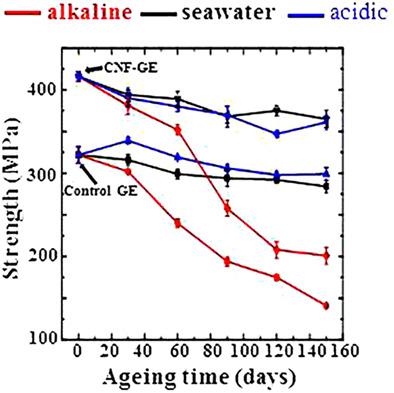当前位置:
X-MOL 学术
›
J. Appl. Polym. Sci.
›
论文详情
Our official English website, www.x-mol.net, welcomes your
feedback! (Note: you will need to create a separate account there.)
Effects of acid, alkaline, and seawater aging on the mechanical and thermomechanical properties of glass fiber/epoxy composites filled with carbon nanofibers
Journal of Applied Polymer Science ( IF 2.7 ) Pub Date : 2019-08-31 , DOI: 10.1002/app.48434 Rani Kattaguri 1 , Abhinav Omprakash Fulmali 1 , Rajesh Kumar Prusty 1 , Bankim Chandra Ray 1
Journal of Applied Polymer Science ( IF 2.7 ) Pub Date : 2019-08-31 , DOI: 10.1002/app.48434 Rani Kattaguri 1 , Abhinav Omprakash Fulmali 1 , Rajesh Kumar Prusty 1 , Bankim Chandra Ray 1
Affiliation

|
Owing to the superior corrosion resistance, fiber‐reinforced polymer (FRP) composites are the prime choice of structural materials for various marine and chemical industries, where there is a long‐term direct contact of the components takes place with corrosive fluids. In this present work, glass fiber/epoxy (GE) composites have been fabricated with and without carbon nanofibers (CNFs), and aging has been carried out in acidic (pH = 1), seawater (pH = 8.2), and alkaline (pH = 13) solutions for 150 days. The resistance of CNF‐filled GE composites toward the corrosive fluids has been evaluated in terms of alteration in the mechanical (flexural), microstructural (fractography analysis by field emission scanning electron microscope), and thermomechanical (dynamic mechanical analysis) behavior of the materials. It is revealed that as the immersion time increases, there is a continuous decrement in flexural strength and modulus, and glass‐transition temperature (Tg) of all the materials in all these solutions. Compared to the 1% CNF‐filled GE composite, control GE composite showed more degradation in the case of alkaline aging and seawater aging. Maximum reduction (56%) in the strength of GE composite was observed due to 150 days of alkaline aging. However, the control GE composite showed better resistance to the acidic solution than that of CNF‐filled GE composite. Possible failure modes, changes in the chemistry of the material due to aging have been studied by fractography analysis. © 2019 Wiley Periodicals, Inc. J. Appl. Polym. Sci. 2020, 137, 48434.
中文翻译:

酸,碱和海水老化对填充碳纳米纤维的玻璃纤维/环氧树脂复合材料的机械和热机械性能的影响
由于具有优异的耐腐蚀性,纤维增强聚合物(FRP)复合材料是各种海洋和化学工业中结构材料的首选,在这些工业中,组件与腐蚀液长期直接接触。在本工作中,使用和不使用碳纳米纤维(CNF)制作了玻璃纤维/环氧树脂(GE)复合材料,并在酸性(pH = 1),海水(pH = 8.2)和碱性(pH = 13)150天的解决方案。评估了CNF填充的GE复合材料对腐蚀性流体的抵抗力,包括材料的机械(弯曲),微观结构(通过场发射扫描电子显微镜进行的断口分析)和热机械(动态力学分析)行为的变化。所有这些解决方案中所有材料的T g)。与含1%CNF的GE复合材料相比,在碱性老化和海水老化的情况下,对照GE复合材料的降解程度更高。由于150天的碱性老化,观察到GE复合材料的强度最大降低(56%)。但是,与GEF填充的GE复合材料相比,对照GE复合材料对酸性溶液的耐受性更好。可能的失效模式,由于老化引起的材料化学变化已通过分形分析进行了研究。分级为4 +©2019 Wiley Periodicals,Inc.J.Appl。Polym。科学 2020,137,48434。
更新日期:2019-12-02
中文翻译:

酸,碱和海水老化对填充碳纳米纤维的玻璃纤维/环氧树脂复合材料的机械和热机械性能的影响
由于具有优异的耐腐蚀性,纤维增强聚合物(FRP)复合材料是各种海洋和化学工业中结构材料的首选,在这些工业中,组件与腐蚀液长期直接接触。在本工作中,使用和不使用碳纳米纤维(CNF)制作了玻璃纤维/环氧树脂(GE)复合材料,并在酸性(pH = 1),海水(pH = 8.2)和碱性(pH = 13)150天的解决方案。评估了CNF填充的GE复合材料对腐蚀性流体的抵抗力,包括材料的机械(弯曲),微观结构(通过场发射扫描电子显微镜进行的断口分析)和热机械(动态力学分析)行为的变化。所有这些解决方案中所有材料的T g)。与含1%CNF的GE复合材料相比,在碱性老化和海水老化的情况下,对照GE复合材料的降解程度更高。由于150天的碱性老化,观察到GE复合材料的强度最大降低(56%)。但是,与GEF填充的GE复合材料相比,对照GE复合材料对酸性溶液的耐受性更好。可能的失效模式,由于老化引起的材料化学变化已通过分形分析进行了研究。分级为4 +©2019 Wiley Periodicals,Inc.J.Appl。Polym。科学 2020,137,48434。


















































 京公网安备 11010802027423号
京公网安备 11010802027423号